Lingyao Li
Patients Speak, AI Listens: LLM-based Analysis of Online Reviews Uncovers Key Drivers for Urgent Care Satisfaction
Mar 26, 2025Abstract:Investigating the public experience of urgent care facilities is essential for promoting community healthcare development. Traditional survey methods often fall short due to limited scope, time, and spatial coverage. Crowdsourcing through online reviews or social media offers a valuable approach to gaining such insights. With recent advancements in large language models (LLMs), extracting nuanced perceptions from reviews has become feasible. This study collects Google Maps reviews across the DMV and Florida areas and conducts prompt engineering with the GPT model to analyze the aspect-based sentiment of urgent care. We first analyze the geospatial patterns of various aspects, including interpersonal factors, operational efficiency, technical quality, finances, and facilities. Next, we determine Census Block Group(CBG)-level characteristics underpinning differences in public perception, including population density, median income, GINI Index, rent-to-income ratio, household below poverty rate, no insurance rate, and unemployment rate. Our results show that interpersonal factors and operational efficiency emerge as the strongest determinants of patient satisfaction in urgent care, while technical quality, finances, and facilities show no significant independent effects when adjusted for in multivariate models. Among socioeconomic and demographic factors, only population density demonstrates a significant but modest association with patient ratings, while the remaining factors exhibit no significant correlations. Overall, this study highlights the potential of crowdsourcing to uncover the key factors that matter to residents and provide valuable insights for stakeholders to improve public satisfaction with urgent care.
ADO: Automatic Data Optimization for Inputs in LLM Prompts
Feb 17, 2025Abstract:This study explores a novel approach to enhance the performance of Large Language Models (LLMs) through the optimization of input data within prompts. While previous research has primarily focused on refining instruction components and augmenting input data with in-context examples, our work investigates the potential benefits of optimizing the input data itself. We introduce a two-pronged strategy for input data optimization: content engineering and structural reformulation. Content engineering involves imputing missing values, removing irrelevant attributes, and enriching profiles by generating additional information inferred from existing attributes. Subsequent to content engineering, structural reformulation is applied to optimize the presentation of the modified content to LLMs, given their sensitivity to input format. Our findings suggest that these optimizations can significantly improve the performance of LLMs in various tasks, offering a promising avenue for future research in prompt engineering. The source code is available at https://anonymous.4open.science/r/ADO-6BC5/
Sympathy over Polarization: A Computational Discourse Analysis of Social Media Posts about the July 2024 Trump Assassination Attempt
Jan 17, 2025



Abstract:On July 13, 2024, at the Trump rally in Pennsylvania, someone attempted to assassinate Republican Presidential Candidate Donald Trump. This attempt sparked a large-scale discussion on social media. We collected posts from X (formerly known as Twitter) one week before and after the assassination attempt and aimed to model the short-term effects of such a ``shock'' on public opinions and discussion topics. Specifically, our study addresses three key questions: first, we investigate how public sentiment toward Donald Trump shifts over time and across regions (RQ1) and examine whether the assassination attempt itself significantly affects public attitudes, independent of the existing political alignments (RQ2). Finally, we explore the major themes in online conversations before and after the crisis, illustrating how discussion topics evolved in response to this politically charged event (RQ3). By integrating large language model-based sentiment analysis, difference-in-differences modeling, and topic modeling techniques, we find that following the attempt the public response was broadly sympathetic to Trump rather than polarizing, despite baseline ideological and regional disparities.
Game-theoretic LLM: Agent Workflow for Negotiation Games
Nov 12, 2024



Abstract:This paper investigates the rationality of large language models (LLMs) in strategic decision-making contexts, specifically within the framework of game theory. We evaluate several state-of-the-art LLMs across a spectrum of complete-information and incomplete-information games. Our findings reveal that LLMs frequently deviate from rational strategies, particularly as the complexity of the game increases with larger payoff matrices or deeper sequential trees. To address these limitations, we design multiple game-theoretic workflows that guide the reasoning and decision-making processes of LLMs. These workflows aim to enhance the models' ability to compute Nash Equilibria and make rational choices, even under conditions of uncertainty and incomplete information. Experimental results demonstrate that the adoption of these workflows significantly improves the rationality and robustness of LLMs in game-theoretic tasks. Specifically, with the workflow, LLMs exhibit marked improvements in identifying optimal strategies, achieving near-optimal allocations in negotiation scenarios, and reducing susceptibility to exploitation during negotiations. Furthermore, we explore the meta-strategic considerations of whether it is rational for agents to adopt such workflows, recognizing that the decision to use or forgo the workflow constitutes a game-theoretic issue in itself. Our research contributes to a deeper understanding of LLMs' decision-making capabilities in strategic contexts and provides insights into enhancing their rationality through structured workflows. The findings have implications for the development of more robust and strategically sound AI agents capable of navigating complex interactive environments. Code and data supporting this study are available at \url{https://github.com/Wenyueh/game_theory}.
AIPatient: Simulating Patients with EHRs and LLM Powered Agentic Workflow
Sep 27, 2024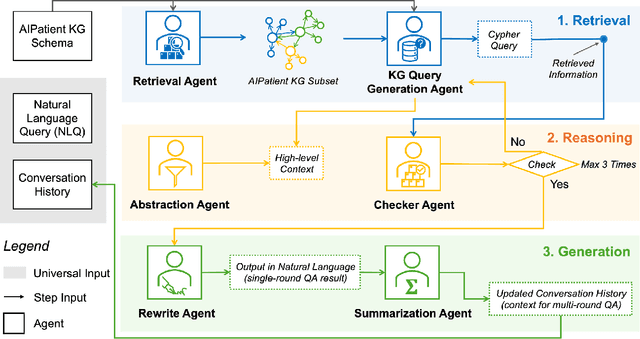
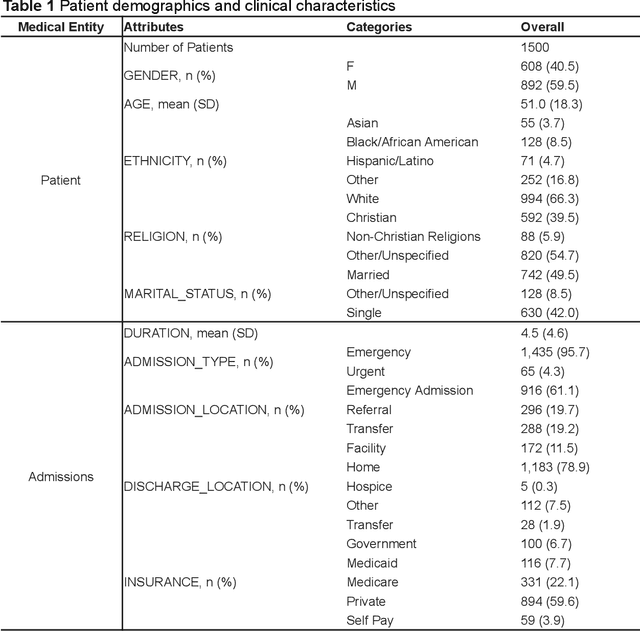
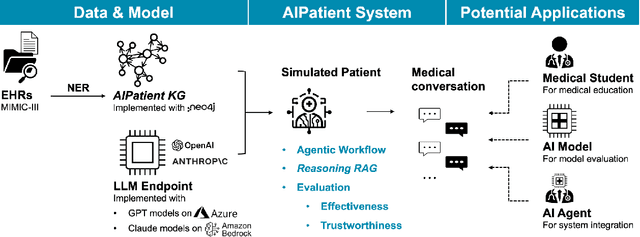

Abstract:Simulated patient systems play a crucial role in modern medical education and research, providing safe, integrative learning environments and enabling clinical decision-making simulations. Large Language Models (LLM) could advance simulated patient systems by replicating medical conditions and patient-doctor interactions with high fidelity and low cost. However, ensuring the effectiveness and trustworthiness of these systems remains a challenge, as they require a large, diverse, and precise patient knowledgebase, along with a robust and stable knowledge diffusion to users. Here, we developed AIPatient, an advanced simulated patient system with AIPatient Knowledge Graph (AIPatient KG) as the input and the Reasoning Retrieval-Augmented Generation (Reasoning RAG) agentic workflow as the generation backbone. AIPatient KG samples data from Electronic Health Records (EHRs) in the Medical Information Mart for Intensive Care (MIMIC)-III database, producing a clinically diverse and relevant cohort of 1,495 patients with high knowledgebase validity (F1 0.89). Reasoning RAG leverages six LLM powered agents spanning tasks including retrieval, KG query generation, abstraction, checker, rewrite, and summarization. This agentic framework reaches an overall accuracy of 94.15% in EHR-based medical Question Answering (QA), outperforming benchmarks that use either no agent or only partial agent integration. Our system also presents high readability (median Flesch Reading Ease 77.23; median Flesch Kincaid Grade 5.6), robustness (ANOVA F-value 0.6126, p<0.1), and stability (ANOVA F-value 0.782, p<0.1). The promising performance of the AIPatient system highlights its potential to support a wide range of applications, including medical education, model evaluation, and system integration.
Recent advances in deep learning and language models for studying the microbiome
Sep 15, 2024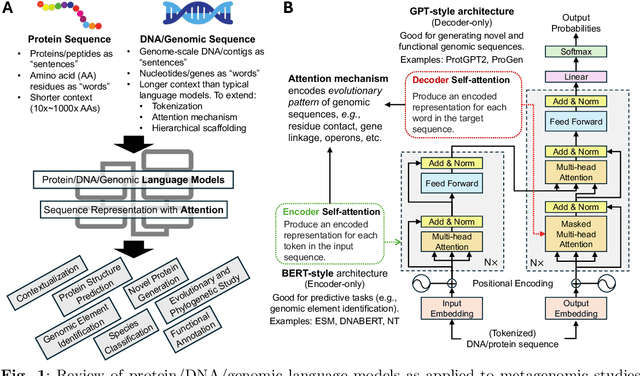

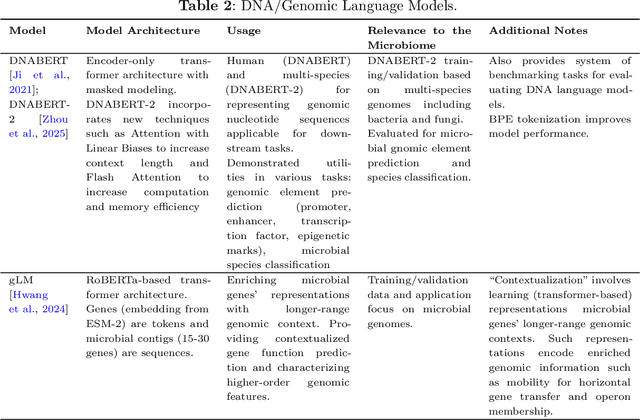

Abstract:Recent advancements in deep learning, particularly large language models (LLMs), made a significant impact on how researchers study microbiome and metagenomics data. Microbial protein and genomic sequences, like natural languages, form a language of life, enabling the adoption of LLMs to extract useful insights from complex microbial ecologies. In this paper, we review applications of deep learning and language models in analyzing microbiome and metagenomics data. We focus on problem formulations, necessary datasets, and the integration of language modeling techniques. We provide an extensive overview of protein/genomic language modeling and their contributions to microbiome studies. We also discuss applications such as novel viromics language modeling, biosynthetic gene cluster prediction, and knowledge integration for metagenomics studies.
Characterizing Online Toxicity During the 2022 Mpox Outbreak: A Computational Analysis of Topical and Network Dynamics
Aug 21, 2024



Abstract:Background: Online toxicity, encompassing behaviors such as harassment, bullying, hate speech, and the dissemination of misinformation, has become a pressing social concern in the digital age. The 2022 Mpox outbreak, initially termed "Monkeypox" but subsequently renamed to mitigate associated stigmas and societal concerns, serves as a poignant backdrop to this issue. Objective: In this research, we undertake a comprehensive analysis of the toxic online discourse surrounding the 2022 Mpox outbreak. Our objective is to dissect its origins, characterize its nature and content, trace its dissemination patterns, and assess its broader societal implications, with the goal of providing insights that can inform strategies to mitigate such toxicity in future crises. Methods: We collected more than 1.6 million unique tweets and analyzed them from five dimensions, including context, extent, content, speaker, and intent. Utilizing BERT-based topic modeling and social network community clustering, we delineated the toxic dynamics on Twitter. Results: We identified five high-level topic categories in the toxic online discourse on Twitter, including disease (46.6%), health policy and healthcare (19.3%), homophobia (23.9%), politics (6.0%), and racism (4.1%). Through the toxicity diffusion networks of mentions, retweets, and the top users, we found that retweets of toxic content were widespread, while influential users rarely engaged with or countered this toxicity through retweets. Conclusions: By tracking topical dynamics, we can track the changing popularity of toxic content online, providing a better understanding of societal challenges. Network dynamics spotlight key social media influencers and their intents, indicating that addressing these central figures in toxic discourse can enhance crisis communication and inform policy-making.
Prompt Design Matters for Computational Social Science Tasks but in Unpredictable Ways
Jun 17, 2024Abstract:Manually annotating data for computational social science tasks can be costly, time-consuming, and emotionally draining. While recent work suggests that LLMs can perform such annotation tasks in zero-shot settings, little is known about how prompt design impacts LLMs' compliance and accuracy. We conduct a large-scale multi-prompt experiment to test how model selection (ChatGPT, PaLM2, and Falcon7b) and prompt design features (definition inclusion, output type, explanation, and prompt length) impact the compliance and accuracy of LLM-generated annotations on four CSS tasks (toxicity, sentiment, rumor stance, and news frames). Our results show that LLM compliance and accuracy are highly prompt-dependent. For instance, prompting for numerical scores instead of labels reduces all LLMs' compliance and accuracy. The overall best prompting setup is task-dependent, and minor prompt changes can cause large changes in the distribution of generated labels. By showing that prompt design significantly impacts the quality and distribution of LLM-generated annotations, this work serves as both a warning and practical guide for researchers and practitioners.
Disentangling Logic: The Role of Context in Large Language Model Reasoning Capabilities
Jun 04, 2024Abstract:This study intends to systematically disentangle pure logic reasoning and text understanding by investigating the contrast across abstract and contextualized logical problems from a comprehensive set of domains. We explore whether LLMs demonstrate genuine reasoning capabilities across various domains when the underlying logical structure remains constant. We focus on two main questions (1) Can abstract logical problems alone accurately benchmark an LLM's reasoning ability in real-world scenarios, disentangled from contextual support in practical settings? (2) Does fine-tuning LLMs on abstract logic problem generalize to contextualized logic problems and vice versa? To investigate these questions, we focus on standard propositional logic, specifically propositional deductive and abductive logic reasoning. In particular, we construct instantiated datasets for deductive and abductive reasoning with 4 levels of difficulty, encompassing 12 distinct categories or domains based on the categorization of Wikipedia. Our experiments aim to provide insights into disentangling context in logical reasoning and the true reasoning capabilities of LLMs and their generalization potential. The code and dataset are available at: https://github.com/agiresearch/ContextHub.
BattleAgent: Multi-modal Dynamic Emulation on Historical Battles to Complement Historical Analysis
Apr 23, 2024



Abstract:This paper presents BattleAgent, an emulation system that combines the Large Vision-Language Model and Multi-agent System. This novel system aims to simulate complex dynamic interactions among multiple agents, as well as between agents and their environments, over a period of time. It emulates both the decision-making processes of leaders and the viewpoints of ordinary participants, such as soldiers. The emulation showcases the current capabilities of agents, featuring fine-grained multi-modal interactions between agents and landscapes. It develops customizable agent structures to meet specific situational requirements, for example, a variety of battle-related activities like scouting and trench digging. These components collaborate to recreate historical events in a lively and comprehensive manner while offering insights into the thoughts and feelings of individuals from diverse viewpoints. The technological foundations of BattleAgent establish detailed and immersive settings for historical battles, enabling individual agents to partake in, observe, and dynamically respond to evolving battle scenarios. This methodology holds the potential to substantially deepen our understanding of historical events, particularly through individual accounts. Such initiatives can also aid historical research, as conventional historical narratives often lack documentation and prioritize the perspectives of decision-makers, thereby overlooking the experiences of ordinary individuals. BattelAgent illustrates AI's potential to revitalize the human aspect in crucial social events, thereby fostering a more nuanced collective understanding and driving the progressive development of human society.
 Add to Chrome
Add to Chrome Add to Firefox
Add to Firefox Add to Edge
Add to Edge